by Bruce Wells | Jan 28, 2019 | Petroleum Companies
Alas, there is very little chance your newly found old oil stock certificate will lead to petroleum riches here at Old Oil Stocks in progress G. Few come close to Not a Millionaire from Old Oil Stock about a certificate that spawned lengthy litigation with the Coca-Cola Company.
The American Oil & Gas Historical Society, which depends on your support, does not have resources for extensive research. As AOGHS looks into forum queries as part of its energy education mission, investigations have revealed interesting stories like Mrs. Dysart’s Uraniu Well and Buffalo Bill’s Shoshone Oil Company; others have found questionable dealings during booms and “black gold” fever epidemics like Arctic Explorer turns Oil Promoter.
Visit the Stock Certificate Q & A Forum for updates frequently added to the A-to-Z listing in Is my Old Oil Stock worth Anything? AOGHS will continue to look into forum queries, including these “in progress.”
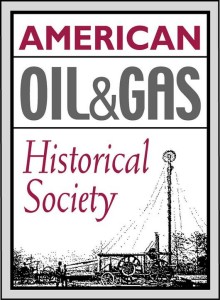
Garfield Oil & Refining Company
The Oklahoma business records department can provide incorporation information on the Garfield Oil & Refining Company, which had properties near Nowata but does not appear to have prospered.
Gate City-Wyoming Oil & Gas Company
The Gate City-Wyoming Oil and Gas Company incorporated in Idaho July 10, 1917, with Pocatello, Idaho, physician Dr. O.B. Steeley as president. The company acquired leases in Wyoming’s Lost Soldier Dome (640 acres); Rattlesnake Dome (640 acres); Laramie Dome (160 acres); and Rock Springs Dome (640 acres). Curiously, the company’s officers and property were also recorded as the Gate City Oil & Gas Company. Dr. Steeley died suddenly in June 1920. The Idaho secretary of state may have further information, but the company’s last filing was in September 1923. Its charter was forfeited on December 1, 1924. Read about other Wyoming wildcatters in First Wyoming Oil Wells and Buffalo Bill’s Shone Oil Company.
Gatex Oil Company
Gatex Oil Company incorporated in Delaware March 1, 1920. The company undertook exploratory “wildcat” drilling in northeast Texas’ Hopkins and Bowie counties with plans to drill in Hunt County. But in Hopkins County, its Davis No. 1 well was abandoned after reaching 2,020 feet deep without finding oil. Similarly in Bowie County, its Perkins No. 1 well was shut down at 1,570 feet deep with no success. Wildcat drilling on unproven land has always been risky; early failures have often exhausted under-capitalized ventures. This seems to have been the case with Gatex Oil Company, which was dissolved on June 4, 1936. (more…)
by Bruce Wells | Mar 11, 2014 | Petroleum Companies
Exploring the companies and Ponzi schemes of a 1920s fake oilman.
Wherever men meet “to tell stories of great achievements of the gigantic industry, someone will always tell, amid a breathless silence, the amazing story of Hog Creek Carruth.”
He called himself J.W. “Hog Creek” Carruth. The investors he betrayed do doubt called him much worse. His “amazing story” began in a Texas boom town.
Hog Creek Carruth Oil Company was one of several Texas exploration companies created by Carruth, who gained his nickname after falsely claiming to have discovered the giant Desdemona oilfield at Hogg Creek.
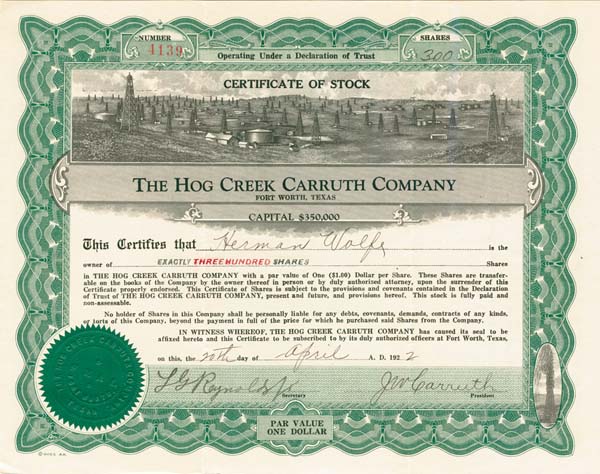
The Hog Creek Carruth Company was among several 1920s companies formed to take advantage of unwary investors seek petroleum wealth in Eastland County, Texas.
In fact, it was Tom Dees and the Hog Creek Oil Company that brought in Desdemona’s discovery well on September 2, 1918. The historic well blew in at 2,000 barrels of oil a day, delighting company investors, who reportedly profited more than $100 for every dollar they had invested. Carruth was among them.
“Hog Creek” Carruth, Stock Promoter
Located along Hog Creek and once called Hogtown, abundant oil production caused Desdemona to boom — and speculators to swarm. As it revelled in its newfound wealth, the town earned a nasty reputation. Texas Rangers had to intervene to keep order. Carruth’s relentless self-promotion and exuberant claims about the discovery soon earned him the “Hog Creek” Carruth moniker.
“The tiny peanut-farming hamlet of Desdemona in Eastland County was transformed when oil was struck in 1918,” notes the Texas State Library and Archives Commission. “Tents and shacks sprang up all around the town to house speculators and workers who flocked to the area, and the population grew from 340 to 16,000 almost overnight.”

Awash with prosperity, people and mud, by April 1920 the Texas Rangers had to be sent into Desdemona to keep order in the oil boomtown.
A contemporary account of the boom reported, “tales of Hogtown during the wicked oil days are too lurid for these pages, but we can say that its debauchery might be so well remembered because so much of it supposedly took place in broad daylight and sometimes not in private.”
Similar Texas drilling booms were taking place in Burkburnett along the Red River and in nearby Ranger, where the “Roaring Ranger” of October 1917 was Eastland County’s first gusher. Read more in Pump Jack Capital of Texas.
With speculators eager to profit from Desdemona, Carruth formed the J. W. Carruth Oil Company in 1919. Despite drilling several dry holes, he profited from selling his exuberantly advertised company stock.
However, just one year after its discovery, the Desdemona oilfield’s production would reach its peak of 7,375,825 barrels and then drop sharply, chiefly because of over drilling, according to the Texas State Historical Association.
Profiting from “Sucker Lists”
J.W. Carruth and his oil company prospered in 1919 by becoming a Ponzi scheme in which Carruth used naïve investors’ purchase money to pay dividends, thereby luring more buyers in a spiral which lined his pockets while emptying theirs. He personally profited by selling his buyers’ personal information.
“Sucker lists” with names, addresses and investment history of people who might buy oil shares had great value. The lists expanded during the multiple oil booms in Eastland County – and similar discoveries in Oklahoma, Kansas and California.
“Depending on the extent and quality of a list, its price ran from several hundred dollars to several thousand,” notes Roger Olien in his 1990 book, Easy Money: Oil Promoters And Investors In The Jazz Age. Predictably for Carruth Oil Company, litigation dogged “Hog Creek” Carruth.
Disputes over leasing and mineral rights continued for several years. He nonetheless sold about $600,000 worth of stock. After more dry holes and more stock sales, in January of 1922, Carruth even announced a new venture.
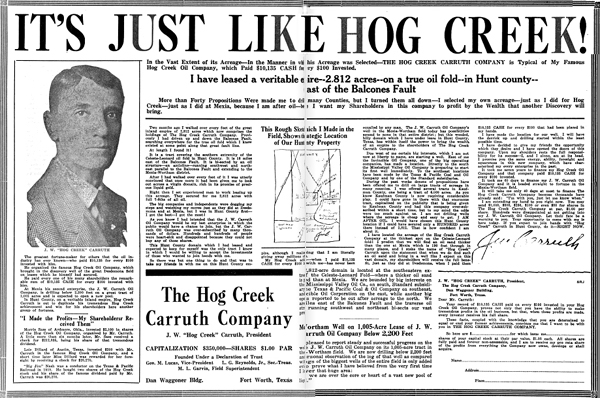
“I have called this company the Hog Creek Carruth Company, since it resembled so closely the famous Hog Creek Oil Company which I organized in 1917 and which in 1918 paid $10,135 cash dividends for every $100 that had been invested in it,” Carruth proclaimed.
Producing a blizzard of full-page promotions in newspapers from Ft. Worth to San Antonio and Port Arthur, the oil stock salesman finally ran afoul of “blue sky” laws, which sought to restrain such scams.
“The advertising of still another promoter, ‘Hog Creek’ Carruth of Fort Worth, Texas, caps the climax,” reported the Providence News on January 3, 1923.
“Modestly he admits that wherever men meet to ‘tell stories of great achievements of the gigantic industry, someone will always tell, amid a breathless silence, the amazing story of Hog Creek Carruth.’”
Indicted in 1923 along with 25 other Texas promoters for “fraudulent use of U.S. mails,” Carruth joined some nationally recognized swindlers.
Among those indicted were some of the most infamous stock promoters of the day: Dr. Frederick Cook, who had falsely claimed to have discovered the North Pole before Robert Perry, and the “genius of bunkum,” Seymour E. J. “Alphabet” Cox, the author of such enticements as, “Oil! Guaranteed Gushers! Five hundred percent, dividends. Pots of gold!”
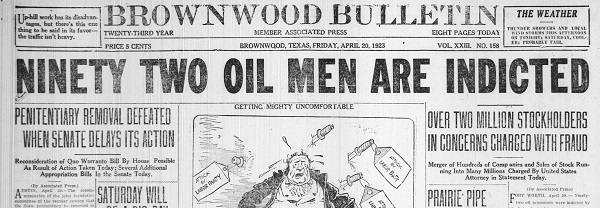 After testimony from almost 300 witnesses and a lengthy trial, Carruth, Cook, Cox and others were convicted of “dispersing stock-sales revenues as dividends, claiming income from non-producing wells, and otherwise misrepresenting the company’s position.”
After testimony from almost 300 witnesses and a lengthy trial, Carruth, Cook, Cox and others were convicted of “dispersing stock-sales revenues as dividends, claiming income from non-producing wells, and otherwise misrepresenting the company’s position.”
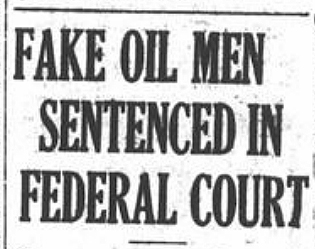 “Hog Creek” Carruth was sent to the Federal Penitentiary in Leavenworth, Kansas for a year. He died in obscurity in 1932.
“Hog Creek” Carruth was sent to the Federal Penitentiary in Leavenworth, Kansas for a year. He died in obscurity in 1932.
In 1934 the Securities and Exchange Commission was established to regulate the issue and sale of securities to protect the public from deceptive stock promotions. Also see the Spear Oil Company and Arctic Explorer turns Oil Promoter.
J.W. “Hog Creek” Carruth’s fraudulent oil ventures (also see Pilgrim Oil Company) have left behind stock certificates as family heirlooms that might some value for some financial certificate collectors. The history of more legitimate exploration companies trying to join petroleum booms (and avoid busts) can be found in Is my Old Oil Stock worth Anything?
_______________________
The American Oil & Gas Historical Society preserves U.S. petroleum history. Join today as an annual AOGHS annual supporting member. Help maintain this energy education website and expand historical research. For more information, contact bawells@aoghs.org. Copyright © 2021 Bruce A. Wells. All rights reserved.
Citation Information – Article Title: “Hog Creek Carruth Oil Company.” Authors: B.A. Wells and K.L. Wells. Website Name: American Oil & Gas Historical Society. URL: https://aoghs.org/oil-almanac/oil-riches-of-merriman-baptist-church. Last Updated: September 9, 2021. Original Published Date: March 11, 2018.
.





 After testimony from almost 300 witnesses and a lengthy trial, Carruth, Cook, Cox and others were convicted of “dispersing stock-sales revenues as dividends, claiming income from non-producing wells, and otherwise misrepresenting the company’s position.”
After testimony from almost 300 witnesses and a lengthy trial, Carruth, Cook, Cox and others were convicted of “dispersing stock-sales revenues as dividends, claiming income from non-producing wells, and otherwise misrepresenting the company’s position.” “Hog Creek” Carruth was sent to the Federal Penitentiary in Leavenworth, Kansas for a year. He died in obscurity in 1932.
“Hog Creek” Carruth was sent to the Federal Penitentiary in Leavenworth, Kansas for a year. He died in obscurity in 1932.